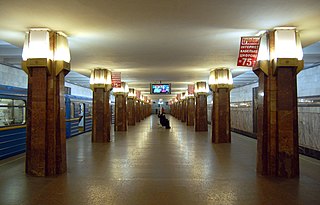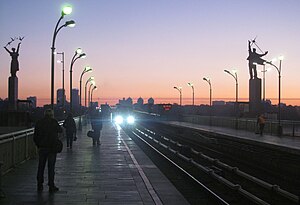
The Kyiv Metro is a rapid transit system in Kyiv owned by the Kyiv City Council and operated by the city-owned company Kyivskyi Metropoliten. It was initially opened on November 6, 1960, as a single 5.24 km (3.26 mi) line with five stations. It was the first rapid transit system in Ukraine.

The Sviatoshynsko–Brovarska line is the first line of the Kyiv Metro, dating back to 1960. It includes some of the system's more historically significant stations, such as Arsenalna, which at 105.5 meters is the deepest in the world and the next station Dnipro, which although the tunnel follows a descent, appears above ground level.

The Kharkiv Metro is the rapid transit system that serves the city of Kharkiv, the second largest city in Ukraine. The metro was the second in Ukraine and the sixth in the USSR when it opened on 22–23 August, 1975. The metro consists of three lines that operate on 38.7 kilometres (24.0 mi) of the route and serve 30 stations. The system transported 223 million passengers in 2018.

Kyiv-Pasazhyrskyi is a railway station in the capital of Ukraine, Kyiv. The station is a railway hub consisting of several railroad station buildings, along with its own repair facilities the Kyiv Electric Railcar Repair Shop, a railway depot with railyard, and the railway sports complex, which is integrated into the cityscape. The station is part of the so-called Kyiv Southern Railway loop.

The Saltivska line is the second line of the Kharkiv Metro operating since 1984, serving Kharkiv, the second largest city in Ukraine. The Saltivska Line is the shortest line segment of the system, at 10.2 kilometres (6.3 mi), with a total of eight stations. Unique to the Kharkiv Metro is the Saltivska line's metro bridge, which passes above the Kharkiv River between the Kyivska and Akademika Barabashova stations.

The Dnipro Metro is a single-line rapid transit system that serves the city of Dnipro, the fourth largest city in Ukraine by population. The metro was the third system constructed in Ukraine, after the Kyiv and Kharkiv metro systems, respectively, when it opened on December 29, 1995. The metro was the fourteenth built in the former Soviet Union region, and the first to open after the collapse of the Soviet Union in 1991.

Arsenalna is a station on the Kyiv Metro's Sviatoshynsko-Brovarska Line. The station was opened along with the first stage and is currently the second-deepest station in the world at 105.5 metres (346 ft), after Hongyancun station of the Chongqing Metro. The depth is attributed to the geography of Kyiv, whose high bank of the Dnipro River rises above the rest of the city. Also unusual is the station's design, which lacks a central concourse and thus is similar in layout to stations of the London Underground.

The Kyiv Tram is a tram network that serves the Ukrainian capital Kyiv. The system was the first electric tramway in the former Russian Empire and the fourth one in Europe after the Berlin, Budapest, and Prague tramways. The Kyiv Tram system currently consists of 139.9 km (86.9 mi) of the track, including 14 km (8.7 mi) of two Rapid Tram lines, served by 21 routes with the use of 523 tram cars. However, the system is being neglected, the serviced track length is decreasing at a fast rate and is replaced by buses and trolleybuses.

Darnytsia is a station on the Kyiv Metro's Sviatoshynsko-Brovarska Line. It was opened on 5 November 1965 as part of the westwards eastwards expansion of the Brovary radius and is the second station located fully on the left bank of the Dnipro River. It's named after the historic neighborhood of Kyiv, Darnytsia.

Lisova is the terminus station of the Sviatoshynsko-Brovarska Line on the Kyiv Metro. It opened on 5 December 1979. It is also the last surface station in Kyiv.

Nyvky is a station on Kyiv Metro's Sviatoshynsko-Brovarska Line. The station was opened on 5 November 1971, and is named after Kyiv's Nyvky neighbourhood. It was designed by Boris Pryimak, I.L. Maslenkov, V.C. Bohdanovskyi, and T.A. Tselikovska.

Sviatoshyn is a station on Kyiv Metro's Sviatoshynsko-Brovarska Line. The station was opened on 5 November 1971, and is named after Kyiv's Sviatoshyn neighborhood. It was designed by H.V. Holovko, N.S. Kolomiiets, and M.M. Syrkin. The station was formerly known as Sviatoshyno.

Poshtova Ploshcha is a station on Kyiv Metro's Obolonsko–Teremkivska Line. The station was opened on 17 December 1976, and is named after Kyiv's Poshtova Square near the Dnieper's embankment in the historic Podil neighbourhood. It was designed by A.S. Krushynskyi, T.A. Tselykovska, I.L. Maslenkov, and V.S. Bohdanovskyi.

Olimpiiska is a station on the Kyiv Metro's Obolonsko–Teremkivska Line. It was opened on 19 December 1981, and was originally named after Kyiv's Republican Stadium as Respublikanskyi Stadion. It was designed by A.S. Krushynskyi, T.A. Tselikovska, A.S. Andriienko, and Y.M. Sharanevych.

Pochaina is a station on Kyiv Metro's Obolonsko–Teremkivska line. The station was opened on 19 December 1980 in the Petrivka neighborhood of the Podilskyi Raion of Kyiv near Pochaina Railway Station. It was designed by I.L. Maslenkov, T.A. Tselikovska, A.S. Krushynskyi, and F.M. Zaremba.

Heroiv Dnipra is a station on Kyiv Metro's Obolonsko–Teremkivska line. The station was opened on 6 November 1982 in the Obolonskyi Raion of Kyiv and was designed by G.D. Andreev. The Metro station is named after the street directly above it.

Klovska is a station on Kyiv Metro's Syretsko-Pecherska Line. Originally the station was a temporary terminus of the line between its opening date 31 December 1989 and prior to the expansion of the line to Vydubychi in December 1991.

Pecherska is a station on Kyiv Metro's Syretsko-Pecherska Line. Originally planned to open along with the main section of the line which in late 1991, problems with the escalator tunnel meant that work was delayed, and the station finally opened only six years later on 27 December 1997.

The Metro Bridge is the first metro bridge, part of the Brovarsky prospect spanning across the Dnieper River in Kyiv, the capital of Ukraine. It was engineered by G. Fuks and Y. Inosov and constructed in 1965 with the expansion of the Kyiv Metro system. The bridge is used for both the Sviatoshynsko-Brovarska Line of the metro and for automobile traffic.

Trukhaniv Ostriv is a station currently under construction on the Kyiv Metro's Podilsko–Vyhurivska line. The station is part of the first segment of the Podilsko-Vyhurivska Line, which is scheduled to be completed after 2022. Construction works at the station are suspended as of June 2020. An opening date of no earlier than 2025 has been set.





















